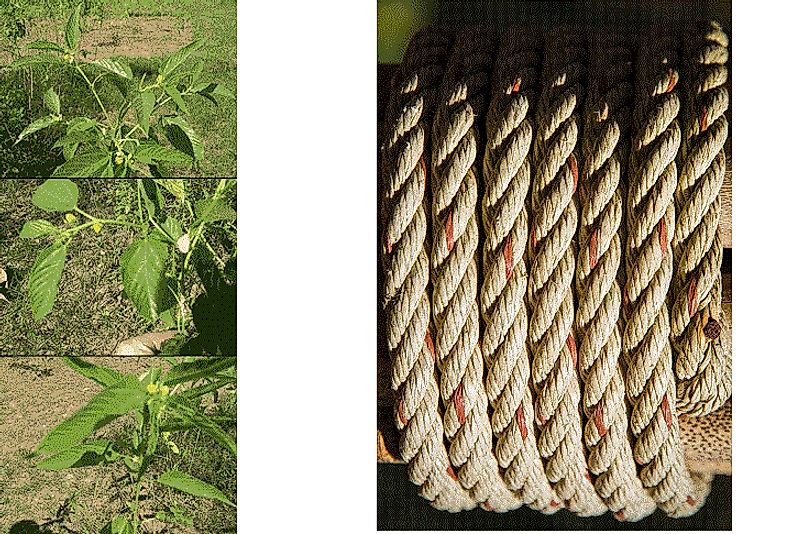What Is Jute Used For, And Where Is It Grown?

The Jute Plant
Jute, a long, soft plant fiber that is spun into coarse, strong threads, is obtained from the plants Corchorus olitorius and Corchorus capsularis. The jute plant, a native of the Indian subcontinent, is a herbaceous annual growing to a height of around 10 to 12 feet with a central cylindrical stem, and 4- to 6-inch long light green leaves and yellow flowers. The jute fibers are located beneath the bark, primarily concentrated near the woody, central parts of the stalk. The two species of the jute plant do not differ much except in terms of quality of the jute fibers, growing habits, and the shapes of their respective seed pods.
History of Jute
For centuries, the jute plant has been extensively cultivated throughout large expanses in the Bengal area of the Indian subcontinent, in the modern day referring to West Bengal in India and southwest Bangladesh. With the arrival of the British, the export of jute outside of India began en masse in the 1790s. In 1822, the manufacture of yarn from imported jute was started in Dundee, Scotland, United Kingdom. India’s own jute manufacturing industry began in Calcutta in 1855. A large number of jute mills, fostered by the Dundee Jute Barons and the British East India Company, started operating here. During the First World War, billions of sandbags manufactured from jute were exported overseas to hold the supplies of soldiers in the war. After the partition of India in 1947, India lost large sections of its best jute-growing lands to what was then Pakistan, and is now Bangladesh.
Types of Jute and Jute Cultivation
Two main varieties of jute are produced today. White jute is obtained from the C. capsularis, while tossa jute is obtained from C. olitorius. The latter variety of jute is stronger, softer, and silkier than the former. The cultivation of jute plants demands a warm and humid climate with plenty of rainfall, and well-drained, loamy soils. Fertilizers and pesticides are hardly needed to grow jute. After the stems are harvested from the plant, they are subjected to "retting", wherein they are steeped into slow running water for 10 to 30 days in order to allow for bacteria to dissolve the gummy materials holding the fibers together. After this retting process is over, the non-fibrous matter of jute is scraped off in a process called "stripping", and then the fibers are separated by beating the stem with a paddle. The separated fibers are then washed, dried, graded, and sent off to jute mills, where they are further processed to make jute yarn. The yarn is then used for the production of the various jute products.
Major Jute Producers of the World
India is the world’s largest producer of jute, and that nation alone produced 1,924,326 metric tons of jute in 2011. Assam, Bihar, and West Bengal are the states of India that are the major producers of jute within that country. Bangladesh is the second major producer of jute globally, producing 1,523,315 metric tons of jute in 2011. Bangladesh is then followed in jute jute production by China, Uzbekistan, Nepal, Vietnam, Myanmar, Zimbabwe, Thailand, and Egypt.
Uses of Jute
The versatile nature of jute makes it a widely popular natural fiber, next only to cotton in commercial significance. Sacks, bags, and coarse cloth used to pack different products, such as bales of raw cotton, are prepared from jute fibers. Jute carpets, jute mats, prayer rugs, and jute furniture are commonly used as well. Jute fibers are also used to make twines and rough cordage. The jute plant, Corchorus olitorius, has culinary applications in some parts of the world, such as Nigeria, Uganda, and the Philippines, where the jute leaves are used as a part of soup preparations. Byproducts of jute mills find limited applications in the cosmetic, pharmaceutical, and paint industries as well. Perhaps the greatest advantage of jute is that it is 100% biodegradable in nature. Unlike synthetic fibers, jute is thus all the more environmentally safe, and hence its use must be greatly promoted as an ecologically friendly way to reduce the world’s dependence on synthetic fibers.











